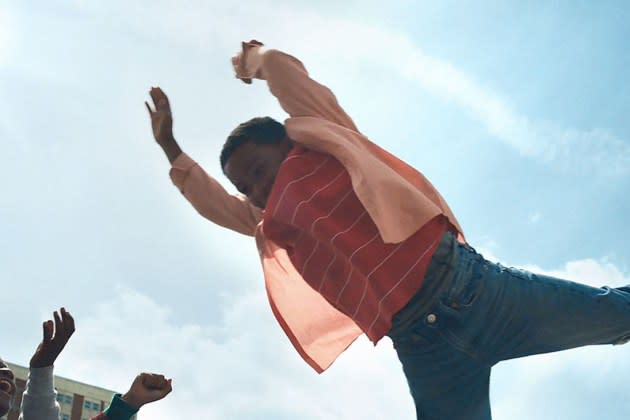‘We Grown Now’ Review: A Delicate Coming-of-Age Story Set in Chicago’s Cabrini-Green Homes
- Oops!Something went wrong.Please try again later.

There’s a game that Malik (Blake Cameron James) and Eric (Gian Knight Ramirez), the protagonists of Minhal Baig’s poignant third feature We Grown Now, like to play. It starts with pilfering mattresses from an empty apartment in their building. They push them down the stairs because the elevators usually don’t work; then, they drag them across the street to the playground. They stack the beds in a corner of the concrete park and, once arranged to their liking, the boys prepare to fly.
Taking off is the easiest part for the two best friends living in the Cabrini-Green homes of Chicago. It’s staying the course once in the air, the seconds just before their bodies collapse into the plush, that proves to be a challenge.
More from The Hollywood Reporter
'Reptile' Director Talks Helming an Emotion-Driven Crime Drama: "I Was Trying to Evoke a Feeling"
Spike Lee Remembers 9/11 at the Toronto Film Festival: "The World Has Changed Since That Day"
Toronto Awards Analysis: Nicolas Cage Zeroes In on Third Oscar Nomination for 'Dream Scenario'
In her sophomore feature Hala, Baig crafted a portrait of a young Muslim woman grappling with the constraints of her religion and teenage realities. The film, which premiered at Sundance, showcased Baig’s directorial vision — a way of seeing that favored intimate and keenly observed moments. With We Grown Now, Baig brings that delicate perceptiveness to a space plagued by a harsh reputation.
The Cabrini-Green homes, a group of towering apartment buildings and row houses, were built in 1942 to house World War II veterans. They were once a model of public housing, but in the 1950s, when more African Americans moved in, management’s neglect caused the place to fall into disrepair. A series of poorly constructed extensions followed, and the neighborhood became a cloister of concrete buildings, sequestered from the surrounding area. The Chicago Housing Authority all but stopped maintaining it, and by the late 90s and early aughts Cabrini-Green was a symbol of broken promises.
Baig sets her feature in 1992. Malik and Eric were born in Cabrini-Green and experience their neighborhood as long walks to elementary school, attempts to fly as high as possible and running between the inner terraces to deliver news and dinners. Working with cinematographer Patrick Sola, Baig renders the housing projects as a maze of red brick buildings and individual apartments as safety zones.
Shots of the building’s interiors — Malik’s living room or Eric’s kitchen, for example — are suffused with a palette of warm colors. They contrast with the gray of the city streets and affirm that inside the concrete structures, intimacy blossoms. Baig is skilled at looking, and in We Grown Now she flexes the dynamism of her perspective. She peeks from between the rust-tattooed legs of a dining room table or from the diamonds of a chain link fence to observe the routines of these families. The result is a film that takes the idea of beauty seriously and works, with deceptive ease, to show us the tiny pleasures that make up life in Cabrini-Green.
We Grown Now moves at an unhurried pace, languidly following Malik and Eric as they rise for the Pledge of Allegiance, pass notes during class, mill about their neighborhood and trade secrets and dreams. There’s not much in the way of a narrative, and We Grown Now struggles as a result. The relaxed approach to storytelling puts pressure on a handful of dramatic moments. For most of the film, Baig’s screenplay lacks the specificity to shape its characters into figures worth emotionally investing in. The adults — Jurnee Smollett plays Malik’s mother Dolores, S. Epatha Merkerson plays his grandmother Anita and Lil Rel Howery plays Eric’s father Jason — don’t have much to work with either. Their personalities remain comparatively shallow.
The action of the film revolves around two pieces of news: a fatal shooting of the boys’ classmate — based on the real life death of seven-year-old Dantrell Davis — and Dolores’ promotion at work. Both events change the texture of Malik and Eric’s daily lives. There’s tension in the air as their neighborhood becomes increasingly swarmed by police officers who, at random, conduct intrusive apartment searches. And the announcement about his mother’s new job thrusts Malik into a state of denial and anxiety about his relationship with Eric. He starts to wonder: What becomes of a friendship when one person moves?
We Grown Now picks up when it builds its third act around Malik’s question. He’s scared and, for a long time, avoids telling Eric that he’s leaving Cabrini-Green. The threat of physical distance heightens the stakes of their daily interactions. Suddenly, every adventure — including a particularly tender trip downtown after they cut school — is tinged with the melancholy of finales.
James and Ramierez are impressive during these moments. The pair have the natural chemistry of elementary school-aged kids navigating change they don’t yet have language for. Malik and Eric bicker, sulk and seek advice from their parents: These conversations, anchored in specific words and feelings, showcase what We Grown Now could have been with a sharper story. Watching the two friends figure out what they mean to each other layers that opening scene in retrospect. Sometimes the hardest part of growth isn’t taking off, but staying the course — together.
Best of The Hollywood Reporter
